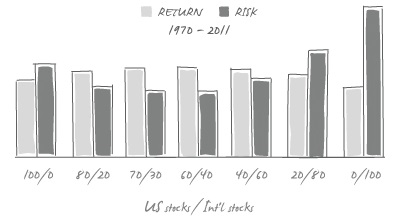There are approximately 5,000 stocks in the U.S. market. With so many companies at home to choose from, why should U.S. investors consider investing abroad? The decision to add any asset class to an investment portfolio should be based on the impact the addition has on the risk and return characteristics of the portfolio. The question to ask is, does adding international stocks increase the portfolio’s potential return and/or reduce the portfolio’s risk? If so, then diversifying globally makes sense.
History shows us international stocks do not represent a source of higher expected returns relative to U.S stocks. Over the past 42 years, average returns for U.S. and international markets have been about the same. From 1970 through 2011, U.S. stocks averaged 10.2% while international stocks averaged 10.1%. In other words, adding international stocks is not a means to boost performance.
The appeal of international diversification is found in its ability to reduce risk. The potential for diversification benefits can be seen by comparing the volatility of a global index with those of U.S. and non-U.S. markets individually. Over the same 42-year period (1970-2011), standard deviation, a measure of average volatility, was 16.1% for U.S. stocks, 17.6% for international stocks, but only 15.3% for global stocks. The global market simply fluctuated less on average than its U.S. or international market components.
This shouldn’t come as a surprise. U.S. and international stocks are exposed to different economic and market forces which produce returns that are less than perfectly correlated (they don’t always move in the same direction at the same time). Since downturns in U.S. and international markets don’t always overlap, global investors enjoy a smoother ride.
The question becomes, how much international exposure should a portfolio have? Non-U.S. stocks currently represent 56% of the global market. Before moving over half of a stock portfolio overseas, however, investors should note international investing is more expensive due to increased transaction costs and management fees. Since you keep what you don’t spend, it is worth considering whether a smaller amount of international exposure can deliver the desired diversification benefits.
Applying the same method used to compare U.S. and international stocks, we can evaluate several global portfolios comprised of different ratios of U.S. to international stocks. As the graph above illustrates, maximum risk reduction has historically been achieved with international exposure of between 30% and 40%.
We currently allocate 33% of stock portfolios to international stocks, but with an additional twist. We favor small company and value stocks in both developed and emerging international markets. Research has shown these stocks to have even lower correlation with U.S. stocks (better diversification) and higher returns than the broad non-U.S. market. Our targeted approach seeks to do even more with less—better diversification, higher returns, and lower costs.

